81 Worked Examples: Airplane, Rocket, & Spacecraft Performance
Many of these worked examples have been fielded as homework problems or exam questions.
Worked Example #1
A propeller-driven airplane has a fuel flow to the engines of the form
where is the weight of fuel burned per unit time,
is the true airspeed,
is the brake specific fuel consumption. The values of
and
depend on the characteristics of the airplane, its weight, and the density altitude at which it is flying, i.e.,
Based on this fuel flow equation, show that the airspeed for the best endurance for the airplane will be obtained when the true airspeed is
and the corresponding airspeed for the best range for the airplane will be obtained when the true airspeed is
Explain the operational significance of flying at and
, and give an example of a flight profile (or a part of one) when such airspeeds might be specifically used.
The first term in the fuel flow equation is the contribution from the profile/parasitic (non-lifting) part of the drag, which grows with the cube of the airspeed. The second part is the contribution from the induced drag, which is inversely proportional to airspeed. Starting from
then the lowest fuel burn (hence maximum flight endurance) can be determined by finding when is a minimum. Differentiating the fuel flow equation with respect to
gives
which is zero for a minimum, i.e.,
and so
The best range is obtained when the ratio is a minimum. In this case
so that
which is zero for a minimum, i.e.,
and so
There are various missions where flying at the optimal speed for the best range or endurance is crucial. For example, an airplane’s long-range ferry mission (such as over water) may require the airplane to be flown at or near its optimal airspeed for maximum range, even though this airspeed is typically lower than the airplane’s best cruise speed. Likewise, flying at an airspeed for best endurance might be necessary for a reconnaissance mission where the airplane must remain at or near a particular location for an extended period.
Worked Example #2
Starting from the steady, level-flight flight assumption of and
, and assuming the engine thrust specific fuel consumption TSFC (
) is constant, then show that for a jet-propelled airplane flying at a constant altitude that the fuel flow to the engines in terms of weight of fuel burned per unit time
can be expressed in the form
where you should evaluate and
in terms of the the wing area,
, wing aspect ratio,
, flight weight,
, parasitic drag coefficient &
, Oswald’s efficiency factor,
, engine TSFC,
.
The standard formula gives the lift on the airplane.
which is equal to the weight . The drag
on the airplane is
where the drag coefficient is given by
i.e., the sum of non-lifting and lifting (induced) parts. is the wing’s aspect ratio, and
is Oswald’s efficiency factor. Using the equation for lift (as well as the assumption that
), the lift coefficient is
Also, because the thrust equals drag, then
and after rearrangement, then
For a jet engine, the fuel burn rate will be the product of the thrust and the thrust-specific fuel consumption, i.e.,
Substituting for gives
or
which is of the form
where
and
Both constants are based on the stated assumptions of all the values involved for a constant weight and altitude, i.e.,
= constant.
Worked Example #3
Using the fuel flow equation from the previous worked example, i.e.,
show that the airspeed for the best endurance for a jet airplane will be obtained when
In this problem, we are asked to start from
The lowest fuel burn (hence maximum flight endurance) can be determined by differentiating the fuel flow equation with respect to , i.e.,
which is zero for a minimum, i.e.,
and so
where
and
Therefore, is the airspeed at which the airplane should fly to obtain the minimum fuel flow. This speed depends on the airplane’s weight and altitude.
Worked Example #4
An ERAU Cessna 172 Skyhawk airplane is flying along at an estimated in-flight weight of 2,100 lb and an airspeed of 120 knots at 2,000 ft, where the air density is 0.00216 slugs/ft. The student pilot is flying solo on a long cross-country flight. When flying over Jacksonville airport on the way back to ERAU (125 nautical miles left to fly), the pilot notices from the fuel gauge that only 8 gallons of usable AVGAS fuel remain in the tanks. Assume that the airplane’s weight for this analysis is the initial in-flight weight minus half the remaining fuel weight. Assume also that AVGAS fuel weighs 6.0 lb per gallon. The engineering characteristics of the airplane are given below:
- Wing span,
= 36 ft
- Wing area,
= 174 ft
- Non-lifting drag coefficient,
= 0.02
- Average propeller efficiency,
= 0.85
- Oswald’s efficiency factor,
= 0.81
- Engine BSFC,
= 0.45 lb hp
hr
Calculate the following:
(a) The operating lift coefficient of the wing, .
(b) The induced drag coefficient, and the total drag coefficient,
.
(c) The lift-to-drag ratio of the airplane.
(d) The propeller thrust and engine power (in hp) required for the airplane to fly.
(e) The fuel flow in gallons per hour. Will the pilot be able to return to ERAU using the remaining fuel?
We are instructed to assume that the airplane’s weight for this analysis is the initial in-flight weight, denoted as , minus half the remaining fuel weight. We have only 8 gallons of AVGAS fuel, and we are told to assume AVGAS weighs 6.0 lb per gallon, so
= 48 lb of fuel. Therefore, the weight to perform the analysis is
An airspeed of 120 kts is equivalent to 120 1.688 = 202.54 ft/s =
.
(a) The operating lift coefficient of the wing, , is
(b) To find the induced drag coefficient, we need the aspect ratio of the wing, , i.e.,
The induced drag coefficient will be
The total drag coefficient, , is
(c) The lift-to-drag ratio of the airplane at the given conditions of flight is
(d) The thrust from the propeller required for the airplane to fly is
The power required for flight will be
where the conversion factor 550 has been used to convert the base USC units to standard units of horsepower (hp).
(e) The fuel flow now follows directly, i.e.,
so the airplane is using about 6 gallons per hour.
(f) The time to burn off all of the relatively small amount of available fuel is
So, the potential approximate range of the airplane is
In conclusion, the airplane has enough fuel to return to ERAU. But, in practice, the FAA requires a minimum fuel reserve of 30 minutes of flight time (visual rules) and 45 minutes of flight time (instrument rules), so legally, the student pilot is probably going to have to land and pick up more fuel before completing the final leg back to ERAU.
Worked Example #5
Consider a small jet-powered airplane with an initial in-flight weight of 21,000 lb flying in unaccelerated level flight at an airspeed of 250 knots where the air density is 0.0015 slugs/ft. The airplane weighs 850 lb of usable fuel remaining in its tanks. The airplane’s wingspan is 48.0 ft, and the wing panels have a trapezoidal shape with a root chord
= 9 ft and a tip chord
= 4 ft. The other characteristics of the airplane are: Non-lifting drag coefficient,
= 0.02; Oswald’s efficiency factor,
= 0.81; Engine TSFC =
= 0.5 lb lb-1 hr-1. Assume for the following analysis that the airplane’s weight from fuel burning is the initial weight minus half the remaining fuel weight. Calculate the following:
(a) The operating lift coefficient of the wing, .
(b) The induced drag coefficient, and the total drag coefficient,
.
(c) The lift-to-drag ratio of the airplane in the given flight conditions.
(d) The thrust required from the engines for the airplane to fly.
(e) The approximate maximum potential remaining flight range of the airplane.
(f) The approximate flight time to reach the remaining flight range.
We need initial information, including the wing area and aspect ratio, as well as the weight at which to run the calculations. Calculating the area of the wing gives
The aspect ratio can be calculated using
We are told to use the weight of the airplane at a point which is its initial weight minus half the remaining fuel weight, so
(a) An airspeed of 250 kts is equal to 422 ft/s. The operating lift coefficient of the wing, , is
(b) The total drag coefficient, , is
(c) The lift-to-drag ratio of the airplane at the given conditions of flight is
(d) The thrust required for the airplane to fly is
(e) The time to burn off all of the relatively small amount of available fuel is
So, the potential approximate range of the airplane is
Worked Example #6
Consider an airplane with a wing of lifting planform area 60 m
, an aspect ratio
12, and Oswald’s efficiency factor
0.90. The wing has a non-lifting profile drag coefficient of 0.01. The remainder of the airplane has a non-lifting drag coefficient of 0.03. All force coefficients are based on wing area
. The mass of the airplane is 16,000 kg. If the airplane is flying at a density altitude of 10,000 ft and its true airspeed is 253 kts, then calculate (a) The lift force produced by the wing; (b) The lift coefficient of the wing; (c) The drag force on the wing; (d) The lift-to-drag ratio of the wing; (e) The total drag force on the airplane; (f) The lift-to-drag ratio of the airplane.
(b) The lift coefficient of the wing is given by
To find , we need the density of the air (in this case, at 10,000 ft) and the true airspeed in units of m/s. The density can be found from the ISA (assuming standard temperature), so
and converting from nautical miles per hour (kts) to m/s gives
Inserting the numbers gives
(c) The drag force on the wing will be given by
where is the drag coefficient of the wing, which will be given by
where the second part is the induced drag (i.e., drag due to lift). Inserting the numbers gives
Therefore, the drag force on the wing is
(d) Now that the lift and drag on the wing are known, the lift-to-drag ratio of the wing is
(e) The total drag force on the airplane is
where is the net drag coefficient of the airplane, which will be given by
where we are given that for the remainder of the airplane, then (the non-lifting part), and the second part will be from the wing (which has already been calculated). Notice that all drag coefficients are defined using wing area as a reference. For the entire airplane, then
Therefore, the drag force on the airplane is
(f) Now the lift and drag are known then, the lift-to-drag ratio of the entire airplane is
Worked Example #7
The goal is to estimate the endurance and range of a general aviation airplane similar to a Cessna 182 Skylane. The parameters describing this propeller-driven airplane are listed in the table below.
| Wing span | 35.8 ft | |
| Wing area | 174 ft |
|
| Wing aspect ratio | 7.37 | |
| Gross takeoff weight | 2,950 lb | |
| Fuel capacity (tankage) | 65 U.S. gals AVGAS | |
| Engine rated power | 230 hp @ MSL ISA | |
| Engine BSFC | 0.45 lb hp |
|
| Parasitic drag coefficient | 0.025 | |
| Oswald’s efficiency factor | 0.8 | |
| Average propeller efficiency | 0.8 |
Based on the provided information, several key performance characteristics of the airplane can be determined, including the power requirements for flight. It can be assumed that the weight of the airplane is the gross takeoff weight, so and so
Rearranging for the lift coefficient gives
Also, the drag coefficient for the airplane (profile drag plus induced drag) is
and so the total drag is
For level flight, the brake power required is
remembering to factor in the propeller efficiency; the power curve is shown in the figure below for a pressure altitude of 5,000 ft, where = 0.002048.
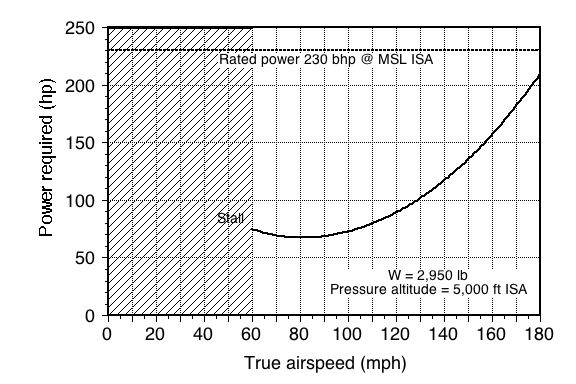
Finally, assuming a constant BSFC gives the fuel flow rate as
which is shown graphically in the figure below.
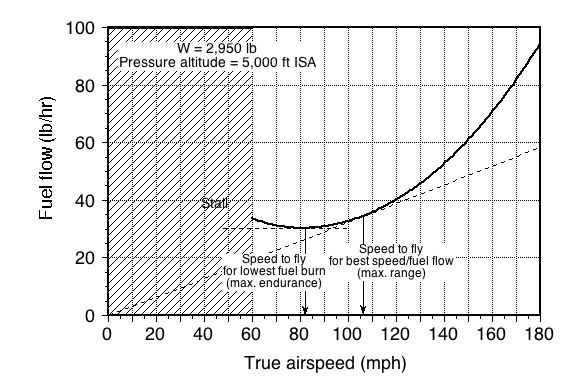
The airplane’s endurance and range can be estimated using the appropriate Breguet formulas. This airplane’s fuel capacity is 65 gallons of AVGAS, and at 6.01 lb per gallon, the maximum fuel weight that could be carried would be 390.65 lb. This is about 13% of the gross weight, so the assumption of constant weight over the flight time is reasonable for evaluating the maximum values of and
. While these values and their corresponding airspeeds will change with weight and altitude, a representative weight for analysis is the in-flight weight, which equals the Gross Takeoff Weight (GTOW) minus half of the total fuel weight.
Not all of this fuel would be usable, however, because at least some quantity of fuel would be needed for startup, taxi, takeoff, and climb, as well as for the descent and landing, plus an allowance of 30 minutes of VFR flight or 45 minutes of IFR flight must be included to comply with FAA regulations. If an average fuel burn allowance of 120 lb is assumed, which seems reasonable for takeoff and landing, this leaves 270 lb of fuel for actual flight use. So, for the endurance and range estimates in this case, then = 2,950-60 = 2,890 lb and
= 2,890 – 270 = 2,620 lb.
The estimated maximum endurance can be found using
From the graph below, the maximum value of is 12.79 at 81 mph or 118.8 ft/s.
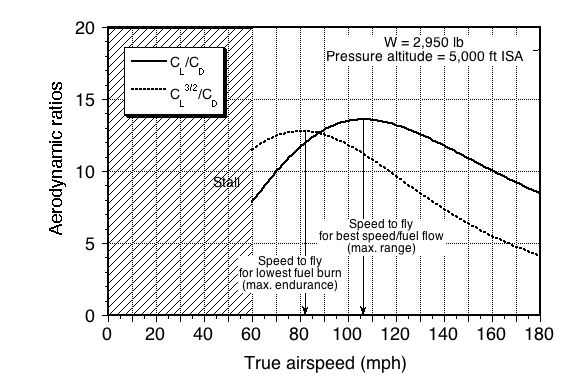
Notice that the BSFC value must be converted into appropriate engineering units so = 0.45/550/3600 = 2.27
in units of (lb) (lb-ft s
)
(s)
. Substituting the appropriate values gives
So, if we loiter, the airplane at or around an airspeed of 81 mph would remain airborne for nearly 10 hours.
The estimated maximum range can be found using
The maximum value of is 13.6 at 106 mph or 155 ft/s.
Substituting the appropriate values gives
which would only be obtained if this airplane were to be flown at or around 106 mph. Of course, this is rather slow compared to the airplane’s top speed, which is around 170 mph; however, at that airspeed, the range would be reduced by nearly half.
Remember that these latter results are only estimates of the maximum range and endurance, but they are typically within 10% of the actual values that can be demonstrated in flight.
Worked Example #8
It is desired to estimate the endurance and range of a jet-powered airplane in the form of a small jet similar to the Cessna Citation. The parameters describing this airplane are listed in the table below.
| Wing span | 53.3 ft | |
| Wing area | 318 ft |
|
| Wing aspect ratio | 8.93 | |
| Gross takeoff weight | 19,815 lb | |
| Fuel capacity (tankage) | 1,119 U.S. gals JET-A | |
| Engine rated thrust ( |
3,650 lb @ MSL ISA | |
| Engine TSFC | 0.6 lb lb |
|
| Parasitic drag coefficient | 0.02 | |
| Oswald’s efficiency factor | 0.81 |
We can assume for the following calculations that the airplane’s weight is the gross takeoff weight, so , although this assumption will tend to overpredict the fuel burn. Alternatively, one can use the
less half the total fuel weight, which is usually considered the preferred approach. The drag coefficient for the airplane is
assuming no transonic wave drag. For level flight, then, the total thrust required is
where
Substituting the known values for our exemplar jet airplane gives the thrust required curve shown below for a pressure altitude of 15,000 ft, where = 0.0014963.
Because this is a twin-engine airplane, each engine would produce half of this required thrust. Assuming a constant TSFC gives the total fuel flow rate as
which is shown in the figure below. Notice that the fuel flow mimics the thrust requirements. For flight at higher airspeeds, the fuel flow increases rapidly, reflecting that for any airplane, there is a high fuel cost associated with flying fast.
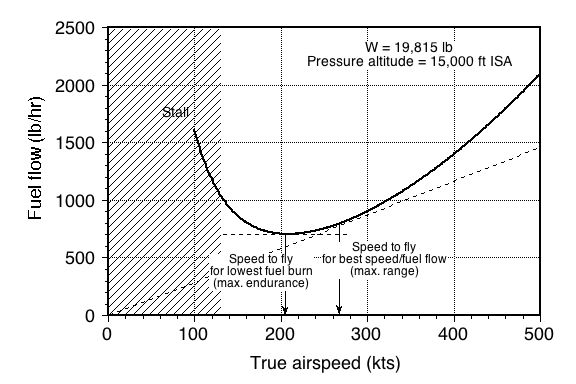
We can estimate the endurance and range of this jet airplane using the appropriate Breguet formulas. We should always use the proper formulas for jet airplanes and distinguish them from propeller airplanes.
The fuel capacity of this jet airplane is 1,119 gallons of JET-A, and at 6.8 pounds per gallon, the maximum fuel weight would be 7,609.2 pounds, which is approximately 38% of the airplane’s gross weight. This is why a more accurate estimate of endurance and range would be obtained by using minus half the total fuel weight. But we will continue here with
. Not all this fuel would be usable, and allowances are needed for previously discussed reasons. We can proceed by assuming that
= 19,815 -1,000 (the 1,000 lb being the allowance) = 18,815 lb and
= 18,815 – 5,600 = 13,215 lb. The endurance is evaluated by using
According to the results provided below, the airplane’s best ratio of 16.85 occurs at an airspeed of 208 kts (351 ft/s). The needed ratios can also be calculated because we have formulas for calculating both
and
.
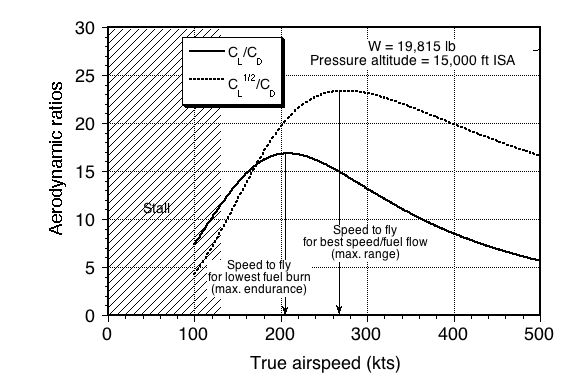
Substituting the numbers and remembering to convert into units of s
by dividing by 3,600 gives
where the final result has been converted back from seconds to hours. The range is evaluated by using
The best ratio of 23.4 occurs at an airspeed of 274 kts or 462 ft/s. Substituting the actual numbers gives
which seems fairly reasonable for this class of jet-powered airplanes. Of course, these results would depend on the payload, which may need to be traded for fuel. Note: For all aircraft, a maximum useful load can be carried, which is the sum of the payload and the fuel load. More payload (e.g., passengers) may, and usually does, allow for less fuel load.
Worked Example #9
A small jet airplane weighs 10,000 lb, has a wing area of 200 ft, and a drag polar given by
. Because of a fuel leak, the airplane runs out of fuel, and the engines stop at an altitude
= 20,000 ft. Estimate the best glide range from this altitude.
The drag polar is given by
Therefore,
Differentiating with respect to gives
which will be zero for a maximum or minimum, i.e.,
or
The drag coefficient at this lift coefficient is
Therefore, the lift-to-drag ratio is
The gliding distance is given by
Worked Example #10 – Flight performance of a drone
A reconnaissance drone aircraft, as shown in the figure below, is cruising in trim in steady flight at an in-flight weight of 3,100 lb at a Mach number of 0.30 at an altitude of 10,000 ft. The aircraft’s drag polar is given by:
The wing has an area of 122.5 ft² and an aspect ratio of 19.6. Assume the following ambient atmospheric conditions: and
.
- Explain the balance of forces and moments acting on the airplane.
- Determine the operating lift coefficient of the wing.
- Determine the induced drag and total drag coefficients.
- Calculate Oswald’s efficiency factor.
- Calculate the total drag force and the lift-to-drag ratio.
- Calculate the brake power required for flight if the propeller efficiency is 0.8.
- If the BSFC of its piston engine is
, approximately how much fuel will be burned in 15 minutes of flying time? Assume that the net change in the aircraft’s weight from burning fuel is negligible.
1. The figure below explains the balance of forces, where lift equals weight and thrust equals drag. All the moments are balanced in trim, so the net moments about all axes are zero.
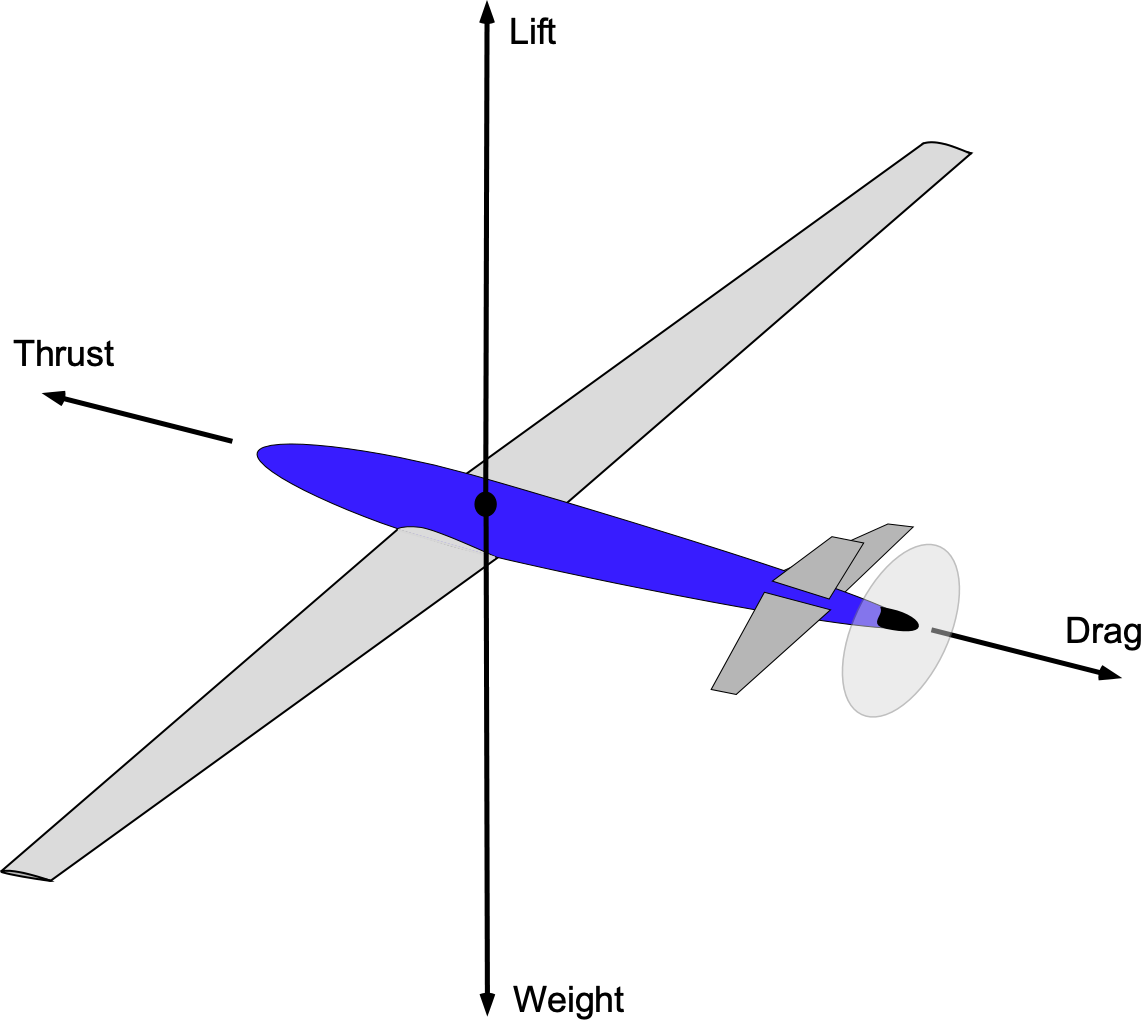
2. The lift equation is given by:
Because , the operating lift coefficient is
The density of air is
The airspeed is
Substituting all the values gives the lift coefficient as
3. The induced drag coefficient is
In this case , so
The total drag coefficient is
4. The induced drag factor is
Rearranging for gives
5. The total drag force is given by
Substituting the values gives
Therefore, the lift-to-drag ratio is
6. The brake power (in hp) required for flight is
Substituting values gives
7. The fuel flow rate is
Substituting gives
For 15 minutes (), then
Worked Example #11
The Nemeth Parasol was an early aircraft designed for short takeoff and landing capabilities. It used a circular wing, which the inventors claimed would operate at very low airspeeds and act as a parachute during landing. In early flight demonstrations, it was claimed that the aircraft came down “almost vertically with a gentle landing.” The diameter of the circular wing was 15 ft, and the aircraft had a total weight of 1,000 lbs.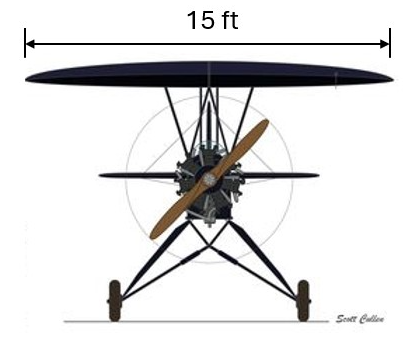
- Calculate the aspect ratio of the circular wing and discuss the implications on induced drag. Why do aircraft typically avoid using wings with such low aspect ratios?
- Assuming the aircraft stalls at a maximum lift coefficient of
= 1.8, estimate the stall speed of the aircraft at sea level standard conditions. Is this value reasonable?
- Calculate the terminal velocity in feet per second at which the aircraft will “parachute” to a landing, assuming purely vertical motion. Hint: The drag coefficient of a circular disk with the flow perpendicular to the disk is 1.4.
- Compare your answers from parts (2) and (3). Would the transition from horizontal forward flight to vertical descent happen smoothly or abruptly? What flight characteristics would help ensure a “gentle” landing?
- You may decide on the outcome from part (c) that a more comfortable vertical landing speed of 12 ft/s would be appropriate. What would the diameter of the circular wing need to be for this scenario?
- What do you think of the inventor’s original claims?
- The aspect ratio,
, of a wing is defined as
where
is the wing span and
is the planform area. For a circular wing of diameter
= 15 ft, the span
and the area is
so that
A low aspect ratio leads to high induced drag because the wing generates strong trailing vortices and inefficient lift distribution. Aircraft typically avoid low aspect ratios to minimize induced drag and achieve improved aerodynamic efficiency, especially during cruise.
- The stall speed,
, can be found from the lift equation at maximum lift, i.e.,
Solving for
gives
The air density at sea level standard conditions is
= 0.002378 slug/ft
, so that
This stall speed is very low and reasonable for an aircraft designed for short takeoff and landing.
- In a vertical descent, the weight of the aircraft is balanced by drag, i.e.,
Solving for
gives
where
= 1.4. Therefore,
- From parts (2) and (3),
51.4 ft/s and
58.3 ft/s. The terminal velocity is slightly higher than the stall speed, suggesting that once the aircraft stalls, it would transition into a somewhat faster vertical descent. The transition would likely be abrupt without careful control.
- Given a desired terminal velocity
= 12 ft/s, solve for required circular wing area,
, using
Substituting values gives
The corresponding diameter is found from
and substituting values gives
Therefore, the diameter of the circular wing would need to be approximately 73 ft to achieve a vertical landing speed of 12 ft/s.
- The inventor’s claims are partially credible. The aircraft likely exhibited low forward stall speeds and significant drag during descent, leading to relatively low and survivable landing speeds. However, the transition to vertical descent might not have been perfectly smooth without careful pilot control, and truly “parachuting” down almost vertically would require a much larger wing to slow the descent to safer speeds.
Worked Example #12 – Propellant needed for a single-stage rocket
A single-stage rocket must provide a speed of 6,000 m/s (6 km/s) to a payload mass, , of 12,000 kg. The vehicle’s structural mass coefficient,
, is 0.06. The propellant used in the engine has a specific impulse,
, of 325 s. What must be the rocket’s initial mass,
, and its propellant mass,
, to meet these requirements?

The equivalent exhaust velocity is
(1)
The initial mass-to-burnout mass ratio, , is
(2)
and the payload ratio, , is
(3)
where is the structural mass coefficient. Therefore, the initial mass of the rocket,
, is
(4)
and the burnout mass, , is
(5)
Finally, the propellant mass, , is
(6)
which is a fairly large rocket.
Worked Example #13
A small rocket is launched vertically from the Earth’s surface with an initial mass of 1,000 kg. If the rocket engine has a thrust of 10 kN and a specific impulse of 250 s, calculate: (a) The rocket’s acceleration at liftoff. (b) The flight velocity of the missile after 30 seconds.
(a) The acceleration at liftoff will be
(b) The equivalent exhaust velocity is
and the thrust from the engine is
The mass flow rate is
Therefore, using the rocket equation, the flight velocity after seconds will be
and inserting the numerical values for = 30 seconds gives
which is just below the speed of sound.
Worked Example #14
Consider a small single-stage rocket with the following design characteristics: propellant mass = 7,200 kg; structural mass = 800 kg; payload mass = 50 kg. The specific impulse for this rocket is 275 s. The rocket blasts off from Earth and climbs vertically. The fuel burns steadily, and the burnout time is 60 seconds. The aerodynamic drag can be neglected, but the effects of gravity should be included. (a) What will be the value of the burnout velocity? (b) Find the thrust generated by the rocket. (c) What is the initial acceleration of the rocket? (d) What will the speed and acceleration of the rocket be 30 seconds into the flight?
(a) The equivalent velocity from the rocket engine will be
The burnout mass has no fuel left, so that this mass will be the sum of the structural mass and payload mass, i.e.,
The initial mass of the rocket has all the unburned fuel, so
With the gravity loss term included, the burnout velocity of the rocket will be
(b) The thrust generated by the rocket will be
(c) With the consideration of gravity, the initial acceleration will be
so about 3.
(d) After 30 seconds from liftoff, the mass of the rocket will be
and so the acceleration at 30 seconds will be
so about 6.
Of course, including aerodynamic drag on the rocket would reduce this value slightly.
Worked Example #15
A single-stage rocket has a total mass of kg and a burnout mass of
kg, including engines, structural shell, and payload. The rocket blasts off from Earth and climbs vertically, exhausting its propellant in 2 minutes and 20 seconds. The propellant burning occurs at a steady rate, and the specific impulse of the propulsion system is 240 seconds. (a) If air resistance and gravity are neglected, what will the rocket’s velocity be at burnout conditions? (b) What thrust does the rocket engine develop at liftoff? (c) What is the initial acceleration of the rocket if gravity is not neglected? (d) What is the acceleration of the rocket at 60 seconds into the flight?
(a) We have that specific impulse is 240 seconds and the initial mass
is 1.14
kg and the burnout mass
is 1.11
kg. Therefore, the propellant mass
will be
The rocket equation (we are told to ignore the gravity loss term in this equation) gives us the change in the velocity of the vehicle , i.e.,
The equivalent exhaust velocity is given in terms of the specific impulse, i.e.,
The burnout velocity is
if we do not include the gravity loss term, as stated.
(b) We need to find the net mass flow rate to the engines. Assuming the rate of propellant consumption is constant, then the mass of the rocket varies over time as
where is the burnout time and
is the rate of burning propellant. The thrust produced,
, will be
(c) The initial acceleration will be
(d) The mass of the rocket at 60 seconds into the flight will be
So, the acceleration will be
Worked Example #16
Use the rocket equation to determine its burnout velocity and maximum achievable height, assuming it was launched vertically. Neglect the aerodynamic drag forces. Solve for the burnout velocity and maximum altitude if the burnout time is 60 seconds. The specific impulse is 250 seconds, the initial mass is 12,700 kg, and the propellant mass is 8,610 kg.
We are given that the specific impulse is 250 seconds, the initial mass
is 12,700 kg, and the propellant mass
is 8,610 kg. The rocket equation gives us the change in the velocity of the vehicle
, i.e.,
where is the initial mass of the vehicle and
is the final or burnout mass. If gravity is included (but no aerodynamic drag), then
where is the burnout time, which is 60 seconds in this case.
The equivalent exhaust velocity is given in terms of the specific impulse, i.e.,
The burnout mass is given by
So now we have the burnout velocity, which is
so
if we do not include the gravity loss term. With the gravity loss term included, then
So at the burnout is reduced to
Assuming the propellant consumption rate is constant, then the mass of the rocket varies over time as
The velocity then is
The height achieved at the burnout time is then.
which, after the application of mathematics, gives
Inserting the values gives
so
The final additional coasting height of the rocket can then be determined by equating the kinetic energy of the rocket at its burnout time with its change in potential energy between that point and the maximum obtained height.
Worked Example #17
A rocket must provide a speed of 6,000 m/s to a payload of 12,000 kg. The vehicle’s structural coefficient is 0.06. The propellants used in the engines have a specific impulse of 325 s. What must the initial mass and propellant mass be to meet these requirements?
The equivalent exhaust velocity
so
and
Therefore, the initial mass is
and the burnout mass is
so the propellant mass is
Worked Example #18
Use the rocket equation to determine a rocket’s burnout velocity and maximum achievable height if its burnout time is 60 seconds. The specific impulse is 250 seconds, the initial mass is 12,700 kg, and the propellant mass is 8,610 kg. Assume the rocket is launched vertically.
The specific impulse is 250 seconds, the initial mass
is 12,700 kg, and the propellant mass
is 8,610 kg. The rocket equation gives us the change in the velocity of the vehicle
, i.e.,
where is the initial mass of the vehicle and
is the final or burnout mass. If gravity is included (but no aerodynamic drag), then
where is the burnout time, which is 60 seconds in this case.
The equivalent exhaust velocity is given in terms of the specific impulse, i.e.,
The burnout mass is given by
So now we have the burnout velocity, which is
so
if we do not include the gravity loss term. With the gravity loss term included, then
So at the burnout is reduced to
Assuming the propellant consumption rate is constant, then the mass of the rocket varies over time as
The velocity is
The height achieved at the burnout time is then.
which, after some mathematics, gives
Inserting the values gives
so
The final additional coasting height of the rocket can then be determined by equating the kinetic energy of the rocket at its burnout time with its change in potential energy between that point and the maximum obtained height.
Worked Example #19
Consider a two-stage rocket with a payload mass = 60 kg. The first stage has two solid rocket boosters attached. First stage: propellant mass = 7,200 kg, structural mass = 800 kg, and mass flow rate = 80.0 kg s. For each booster, the propellant mass is 1,400 kg, the structural mass is 200 kg, and the burn time is 45 seconds. For the second stage: propellant mass = 5,400 kg, structural mass = 600 kg. The specific impulse for the first stage is 250 and 290s for the boosters. Find the extra burnout velocity of the rocket at first-stage separation when using boosters compared to when not using them.
Here is a summary of the information provided:
- Propellant mass for stage 1,
= 7,200 kg
- Propellant mass for stage 2,
= 5,400 kg
- Propellant mass for each booster,
= 1,400 kg
- Structural mass for stage 1,
= 800 kg
- Structural mass for stage 2,
= 600 kg
- Structural mass for each booster,
= 200 kg
- Payload mass,
= 60 kg
- Specific impulse for stage 1,
= 250.0 s
- Specific impulse for boosters,
= 290.0 s
- Burnout time for each booster,
= 45 s
- Mass flow rate for stage 1,
= 80 kg/s
The initial mass, , of the rocket without the boosters is
and inserting the values gives
The burnout mass, , just before the first stage separation is
which gives the burnout mass, , as
Therefore, the increment for the first stage without the boosters is
and inserting the values gives
Therefore, for the first stage, the burnout velocity is
The equivalent exhaust velocity for each booster, , is
and the net thrust, , produced is
The mass flow rate for each booster is
so the net thrust (to augment the thrust of stage 1) will be
remembering that there are two boosters. Notice that the boosters nearly double the thrust at launch.
To obtain the burnout velocity at booster burnout at 45 seconds into the flight, we first need the mean equivalent exhaust velocity for the stage 1 core and the two boosters, which is given by
where . The mass flow rates and the equivalent velocities of the stage 1 core and the boosters have already been calculated, so
The burnout velocity of the rocket at booster burnout, , at
= 45 seconds into the flight is given by
In this case, the initial mass, , of the rocket with the two boosters is
and inserting the values gives
The burnout mass, , at booster burnout at 45 seconds is
noting that the first stage core has burned, in this case, half of its propellant. Therefore, the burnout mass at booster burnout, , is
Therefore, the increment for the first stage at the burnout time is
and inserting the values gives
Therefore, at booster burnout, the velocity of the rocket is
The first stage then burns for another 45 seconds, over which it burns the other half of its propellant. After booster separation, the new initial weight is
and the burnout mass just before stage 1 separation is then
Therefore, the burnout mass is
and so the for this part of the launch is
Inserting the values gives
Therefore, at stage 1 burnout, the velocity of the rocket is
This means the rocket travels nearly twice the velocity it would have traveled without the boosters.
Worked Example #20 – Space Shuttle launch
Consider a Space Shuttle, which is a parallel rocket system launch vehicle. The Shuttle used LH2/LOX for the “core” main engines on the Orbiter, with two solid rocket boosters, or SRBs. It is required to estimate the final burnout velocity. Neglect the gravity loss term in the rocket equation. The information available includes the following:
- Orbiter:
- Structural mass = 110,000 kg
- Payload mass = 24,000 kg
- Specific impulse = 454 seconds
- Burnout time = 480 seconds
- External tank
- Structural mass = 30,000 kg
- Propellant mass = 720,000 kg
- SRB (for each):
- Structural mass = 86,000 kg
- Propellant mass = 500,000 kg
- Specific impulse = 269 seconds
- Burnout time = 124 seconds
For the Orbiter or the “core,” the equivalent exhaust velocity, , is
For the SRBs, the equivalent exhaust velocity, , is
The fraction of propellant mass remaining in the core at booster burnout will be
The mean equivalent exhaust velocity, , is
and putting in the values gives
The initial mass at the point of launch is
and putting in the values gives
The final mass of the vehicle at SRB burnout is
and putting in the values gives
Therefore, the at SRB burnout is
The initial vehicle mass after SRB separation is
and putting in the values gives
The final mass at the depletion of the propellant in the external tank is
The extra at complete burnout is
Therefore, the final burnout velocity of the Orbiter is
which is fairly close to the values quoted by NASA, considering that the gravitational has been neglected.
Worked Example #21 – Change in kinetic energy of a spacecraft
A spacecraft with a mass of 10,000 kg travels with a velocity of 5,000 m/s. If a rocket engine with a specific impulse of 250 seconds is turned on and produces a constant thrust of 50 kN for 100 seconds, then calculate (a) the final velocity of the spacecraft. (b) The change in kinetic energy of the spacecraft.
(a) The final velocity of the spacecraft is given by
(b) The change in kinetic energy of the spacecraft is given by
The initial mass of the spacecraft is 10,000 kg, and the final mass can be determined based on the mass flow rate, i.e.,
giving the final mass as
Therefore, the change in kinetic energy of the spacecraft is
Worked Example #22
A single-stage rocket is launched vertically, carrying a payload of 200 kg. It uses 3,000 kg of propellant and has a structural mass of 400 kg. The engine has a specific impulse of 300s.
- Compute the rocket’s burnout velocity.
- A design proposal reduces the structural mass to 300 kg while keeping everything else the same. What is the new burnout velocity?
- Based on your answers, briefly discuss whether it is more effective to reduce dry mass by 100 kg or increase propellant mass by 100 kg while keeping the same structure. You may assume all else remains constant.
- The burnout velocity for a vertical launch, neglecting the gravity term on
(we are not given the burnout time) and drag, can be found from the ideal rocket equation, i.e.,
where
and
Therfore,
and
Using the rocket equation gives
- With the structural mass reduced to 300 kg, the new masses are
and
so that
Reducing the structural mass by 100 kg increased the burnout velocity from approximately 5,271 m/s to 5,725 m/s, a gain of about 454 m/s.
- If instead the propellant mass were increased by 100 kg (to 3,100 kg), keeping the structural mass at 400 kg, the new masses would be
and
so that
Increasing the propellant mass by 100 kg results in a
increase from 5,271 m/s to 5,355 m/s, a gain of approximately 84 m/s. Therefore, reducing structural (dry) mass is much more effective than increasing propellant mass for improving burnout velocity.


